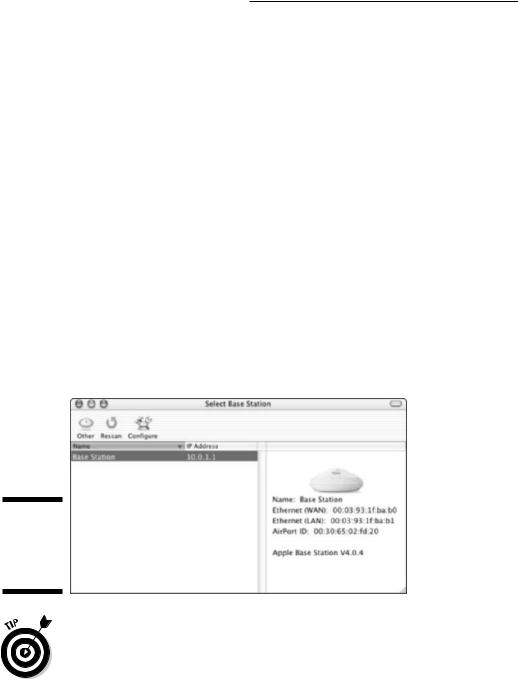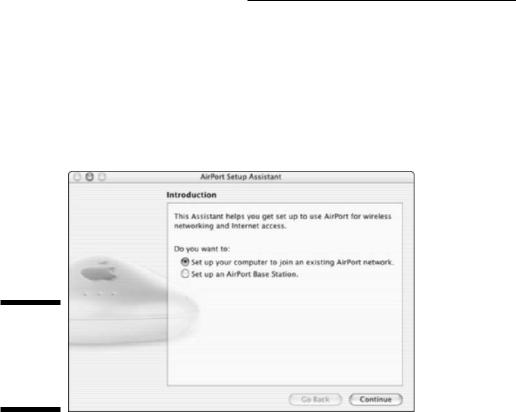
- •About the Authors
- •Dedication
- •Contents at a Glance
- •Table of Contents
- •Introduction
- •About This Book
- •System Requirements
- •How This Book Is Organized
- •Part I: Wireless Networking Fundamentals
- •Part II: Making Plans
- •Part III: Installing a Wireless Network
- •Part IV: Using a Wireless Network
- •Part V: The Part of Tens
- •Icons Used in This Book
- •Where to Go from Here
- •Nothing but Net(work): Why You Need (Or Want) One
- •File sharing
- •Printer and peripheral sharing
- •Internet connection sharing
- •Home arcades and wireless to go
- •Wired versus Wireless
- •Installing wired home networks
- •Installing wireless home networks
- •Picking a Wireless Standard
- •Planning Your Wireless Home Network
- •Workstations and servers
- •Network infrastructure
- •Network interface adapters
- •Get the (Access) Point?
- •Industry Standards
- •Who or What Is Bluetooth?
- •Wi-Fi versus Bluetooth
- •Piconets, Masters, and Slaves
- •Wirelessly synching your PDAs
- •Wireless printing and data transfer
- •Integrating HPNA and HomePlug with Your Wireless Home Network
- •Home Phoning (ET Got It Backward!)
- •Network Power(line)!
- •Deciding What Is Connected to the Network
- •Counting network devices
- •Choosing wired or wireless
- •Choosing a wireless technology
- •Choosing an access point
- •Deciding where to install the AP
- •Adding printers
- •Adding entertainment and more
- •Connecting to the Internet
- •Budgeting for Your Wireless Network
- •Pricing access points
- •Pricing wireless network adapters
- •A sample budget
- •Planning Security
- •Selecting Access Points
- •Certification and Standards Support
- •Compatibility and Form Factor
- •DHCP servers
- •Gateways, NAT, and cable/DSL routers
- •Switches
- •Print servers
- •Operational Features
- •Security
- •Range and Coverage Issues
- •Manageability
- •Web-based configuration
- •Software programming
- •Telnetting to your device
- •Upgradeable firmware
- •Price
- •Warranties
- •Customer and Technical Support
- •Before Getting Started, Get Prepared
- •Setting Up the Access Point
- •Preparing to install a wireless AP
- •Installing the AP
- •Configuring AP parameters
- •Changing the AP Configuration
- •Installing device drivers and client software
- •PC Cards and mini-PCI cards
- •Compact Flash cards
- •PCI and ISA cards
- •USB adapters
- •Modifying Wireless Network Adapters
- •Synchronizing and Internet Access
- •Wireless Zero Configuration with XP
- •Easy installation
- •Automatic network connections
- •Tracking Your Network’s Performance
- •Apple AirPort Hardware
- •Pick an AirPort Card, any card
- •Apple AirPort Software Updates
- •AirPort 2.0 software
- •AirPort 2.0.4 software
- •AirPort 2.0.5 software
- •AirPort 2.1.1 software
- •OS 9 Wireless Networks
- •Installing AirPort software on Mac OS 9
- •Upgrading AirPort Base Station firmware on OS 9
- •OS X Wireless Networks
- •Installing the AirPort software on OS X
- •Upgrading AirPort Base Station firmware on OS X
- •Adding another computer to your AirPort network on OS X
- •Connection sharing
- •Routers and gateways
- •Sharing dialup Internet connections
- •Obtaining an IP Address Automatically
- •Windows 9x
- •Windows 2000
- •Windows XP
- •Setting Up Internet Connection Sharing
- •Windows 98 SE and Windows Me
- •Windows 2000
- •Windows XP
- •Mac OS X v. 10.2 (Jaguar)
- •Assessing the Risks
- •General Internet security
- •Airlink security
- •How about a bit more about WEP?
- •What’s wrong with WEP?
- •Clamping Down on Your Wireless Home Network’s Security
- •Getting rid of the defaults
- •Enabling WEP
- •Closing your network
- •Looking into the Crystal Ball
- •Waiting for WPA
- •The future: 802.11i
- •A Networking Review
- •Basic networking terminology
- •Setting up a workgroup
- •Will You Be My Neighbor?
- •Sharing a document or folder on Windows 95/98/Me
- •Enabling sharing on Windows 2000/XP
- •Setting permissions
- •Accessing shared files
- •Be Economical: Share Those Peripherals
- •Setting up a print server
- •Sharing other peripherals
- •PC Gaming Hardware Requirements
- •Networking Requirements for PC Gaming
- •Console online gaming services and equipment
- •Console wireless networking equipment
- •Dealing with Router Configurations
- •Getting an IP address
- •Dealing with port forwarding
- •Setting Up a Demilitarized Zone (DMZ)
- •Wireless Home Entertainment Gear
- •Expanding Your Home Entertainment Center with Wireless Adapters
- •The Home Media Player
- •The Home Theater PC
- •Internet Content for Your Media Players and HTPCs
- •Making a Connection to Your Car
- •Your car’s path to wireless enlightenment
- •Synching your car stereo with home
- •Getting online with your own car PC
- •Picking wireless gear for your car
- •Using your PDA as a remote control
- •Whole home 802.11-based IR coverage
- •See me, feel me, hear me, touch me
- •Discovering Bluetooth Basics
- •Bluetooth Mobile Phones
- •Bluetooth PDAs
- •Other Bluetooth Devices
- •Printers
- •Digital cameras
- •Keyboards and meeses (that’s plural for mouse!)
- •Bluetooth adapters
- •Discovering Public Hot Spots
- •Freenets and open access points
- •For-pay services
- •Using T-Mobile Hot Spots
- •Using Wayport Hot Spots
- •Using Boingo Hot Spots
- •Tools for Finding Hot Spots
- •Netstumbler.com
- •Boingo
- •Check the Obvious
- •Move the Access Point
- •Move the Antenna(s)
- •Change Channels
- •Check for Dual-Band Interference
- •Check for New Obstacles
- •Install Another Antenna
- •Add a Signal Booster
- •Add a Repeater or Bridge
- •Check Your Cordless Phone Frequencies
- •Your Bath
- •Your Car
- •Your Exercise Gear
- •Your Home Appliances
- •Your Musical Instruments
- •Your Pets
- •Your Phones
- •Your Robots
- •Your Wearing Apparel
- •CNET.com
- •802.11 Planet
- •Broadband Wireless Exchange Magazine
- •80211b.weblogger.com
- •PC Magazine
- •Electronic House Magazine
- •Home Automation Magazine
- •Practically Networked
- •ExtremeTech.com
- •Network World
- •Other Cool Sites
- •Index

152 Part III: Installing a Wireless Network
5.Type the network password for your wireless network in the Password text box and then click the right arrow in the lower-right corner of the window to go to the final panel.
6.Click the Go Ahead button.
7.When a message displays that the AirPort Setup Assistant is done, click the Connect Now button.
The assistant closes itself and launches Internet Explorer. If a Web page displays, the connection is a success, and you’ve added another computer to your wireless home network.
OS X Wireless Networks
AirPort 2.1.1 is the most current version of the AirPort software as of the writing of this book. Consequently, the following discussion describes the steps and shows screen images that relate to AirPort 2.1.1. If you use a later version to set up your AirPort network, the screens might look slightly different.
Even though a CD containing AirPort software is distributed with both
the AirPort Base Station and the AirPort Card, check out the Apple Web site www.info.apple/support/downloads.html to make sure that you have the latest version of the AirPort software before setting up your AirPort network.
To set up an AirPort Base Station using the AirPort 2.1.1 software, you must have the Base Station itself as well as the following:
An AirPort-ready computer with an AirPort Card
Mac OS X version 10.2 or later
If you have a third-party wireless networking card in your PowerBook PC Card slot, use the software that came with the card to configure your network.
When you run the AirPort software installation, you first install (or upgrade) software on your computer and then upgrade the firmware that’s built into the AirPort Base Station. Finally, you configure the Base Station. The sections that follow take you through the process step by step.

Chapter 8: Setting Up a Wireless Mac Network 153
Installing the AirPort software on OS X
To install AirPort software on your computer under OS X, follow these steps:
1.Close all applications.
The installation process will restart your computer, so save your work and close all applications before starting the installation procedure.
2.If you’re installing the software from a CD-ROM, insert the CD-ROM and double-click the Install Mac OS X.pkg package file.
Alternatively, you can download the most current version of the software from the Apple Web site (www.info.apple/support/downloads. html).
If you download the software, the file will bear a .dmg extension denoting it as a disk image file.
3.Double-click the file name.
The Disk Copy application runs, creates a Disk icon on the desktop, and then opens the disk in the Finder.
4.Double-click the package file AirPortSW.pkg in the Finder window.
5.If an Authenticate pane pops up prompting you for a password, enter the password that you use to log on to your computer.
The Welcome to the AirPort Installer panel displays.
6.Click the Continue button to display Important Information; read this information and then click the Continue button to display the Software License Agreement.
7.Read the license agreement; if you agree, click the Continue button and then click the Agree button to display the Select a Destination panel.
8.Chose the drive where you want the software to be installed from the Destination Disk list and then click the Continue button to display the Easy Install panel.
9.Click the Upgrade button and then click the Continue Installation button.
The Installation program installs the software and optimizes system performance, showing you a progress bar while it’s doing so.
10.When a message displays announcing that the software installation was successful, click the Restart button to close the installation software and to restart your computer.

154 Part III: Installing a Wireless Network
Upgrading AirPort Base Station firmware on OS X
In this section, we explain how to upgrade the firmware of a new AirPort Base Station. Upgrading the firmware on your AirPort Base Station through a direct Ethernet cable connection is easiest. Use an Ethernet cable (either a straight-through cable or a cross-over cable; the Base Station automatically detects the type of cable that you’re using) to connect your computer’s Ethernet port to the Base Station’s LAN port. You can also do the upgrade over a wireless connection.
To upgrade the firmware of a new AirPort Base Station that you’re setting up for the first time, follow these steps:
1.Double-click the desktop icon for the hard disk on which you installed the AirPort software.
2.When the hard disk’s folder opens, open the Applications folder and then open the Utilities folder.
3.Double-click the AirPort Admin Utility icon to display the Select Base Station window, shown in Figure 8-5.
Figure 8-5:
The OS X Select Base Station window.
You should see Base Station in the Name list. This is the factory-sup- plied name for your AirPort Base Station. It should have the IP address 10.0.1.1.
4. Highlight the Base Station name and then click the Configure button.

Chapter 8: Setting Up a Wireless Mac Network 155
5.After a message pops up requesting a password, enter public as the password and then click OK.
•If the firmware installed in the Base Station is older than the firmware that was supplied with your updated software, you see a message prompting you that a newer version of the Base Station software is available. Click the Upload button to install it.
•If a message pops up stating that uploading the software will cause the wireless network to be disconnected, click OK. The new firmware is copied to the Base Station.
Note: If the Base Station window displays when you click the Configure button — rather than a message that a newer version of the Base Station software is available — your Base Station already contains the most recent firmware. Close the Base Station window and then close the AirPort Admin Utility.
6.After a message displays that the system is waiting for the Base Station to restart and that the Base Station has been successfully updated, click OK.
7.When the Select Base Station window returns, close it.
8.Disconnect the Ethernet cable between your computer and the Base Station.
Configuring the AirPort Base
Station on OS X
After you’re sure that your AirPort Base Station has the most current firmware, the easiest way to set it up for use in your wireless home network is to use the AirPort Setup Assistant. The AirPort Setup Assistant reads the Internet settings from your computer and transfers them to the Base Station so that you can access the Internet over your wireless network. To use the AirPort Setup Assistant, follow these steps:
1.Before running the AirPort Setup Assistant, set up your computer to connect to the Internet by dialup modem or by broadband (cable or DSL) modem.
Check with your ISP for instructions on getting connected.
•If you connect to the Internet by dialup modem: Connect the telephone line to the phone line port on the Base Station.
•If you connect to the Internet by DSL or cable modem: Use an Ethernet cable to connect the modem to the Base Station’s WAN port.

156 Part III: Installing a Wireless Network
2.Double-click the desktop icon for the hard disk on which you installed the AirPort software.
3.When the hard disk’s folder opens, open the Applications folder and then open the Utilities folder.
4.In the Utilities folder, double-click the AirPort Setup Assistant icon to display the AirPort Setup Assistant window, as shown in Figure 8-6.
Figure 8-6:
The OS X
AirPort
Setup
Assistant
window.
5.Select the Set Up an AirPort Base Station radio button and then click the Continue button in the lower-right corner of the window.
If your computer is in range of only your one wireless network, the Setup Assistant automatically configures your AirPort Card to select that network and proceeds to the America Online Access panel. However, if you happen to be in range of more than one wireless network, you see the Select an AirPort Network panel that asks you to select your network from a pop-up list. Your network will have the name assigned at the factory, similar to Apple Network xxxxxx where xxxxxx is a six-digit hexadecimal number. After selecting your network, click the Continue button to go to the next panel.
6.In the America Online Access panel:
•If you connect to the Internet via AOL: Select the I Am Using American Online radio button and then click the Continue button.
•If you’re not using AOL: Select the I Am Using Another Internet Service Provider radio button and then click the Continue button to display the Internet Access panel.

Chapter 8: Setting Up a Wireless Mac Network 157
7.In the Internet Access panel, choose one of the following options and then click the Continue button:
•Telephone Modem: Select this radio button if you connect to the Internet through a dialup modem. The AirPort Base Station is one of the few wireless access points that includes a 56 Kbps modem.
By choosing this option, all the computers connected to your wireless network might be able to share a single dialup connection.
If you have one of the new Airport Extreme Base Stations, you might not have a built-in version. There are two versions, and the less expensive one does not have a modem.
•Local Area Network: You should select this radio button if your computer is connected to a high-speed LAN.
•Cable Modem or DSL Using Static IP or DHCP: Select this radio button if you connect to the Internet by cable modem or by DSL but only if your ISP doesn’t use the PPP over Ethernet (PPPoE) protocol.
•Cable Modem or DSL Using PPPoE: If your ISP uses the PPPoE protocol, select this radio button. It is important that you make a successful connection to the Internet with your computer connected directly to the cable or DSL modem before attempting to configure the Base Station. The AirPort Setup Assistant will then be able to copy the PPPoE settings from your computer to the Base Station so that the Base Station can log on to the Internet with your user ID and password. All the computers on your wireless network will then be able to share the Internet connection without needing to log on.
The next panel that you see at this step depends on the choice that you make in Step 7:
•Telephone Modem: If you choose Telephone Modem, you see the Modem Access panel with text boxes available for various dialup parameters such as user name, password, and phone number. In most cases, the setup assistant copies this information from your computer.
•LAN, or Broadband Using Static IP or DHCP: If you choose either a LAN or a broadband (cable modem or DSL) connection that doesn’t use PPPoE, the Ethernet Access panel presents the option to use DHCP or to assign a static IP address. If your ISP has assigned you a static IP address — along with other values such as subnet mask, router address, domain name, and/or DHCP client name — you have to enter this data if it isn’t automatically copied from your computer.
